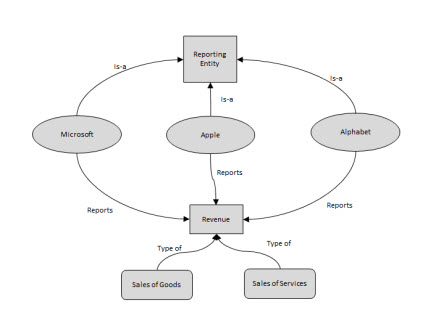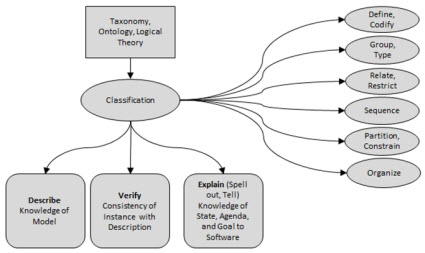It was the Greek philosopher Aristotle (384-322 B.C.) that first came up with the idea of classifying plants and animals by type, essentially creating the notion of a hierarchy or taxonomy. The idea was to group types of plants and animals according to their similarities thus forming something that looked like a "tree" with which most people are familiar.
People tend to be less familiar with the notion of a "graph". A tree, or hierarchy, is actually a type of graph. Trees/hierarchies tend to be easier to get your head around. But the real world can be more complicated than the rather simple relations that can be represented by trees/hierarchies. Here is a simple example:
(Click image for larger view)
When you use some formal, explainable nomenclature (a system of naming) to define things; then you can uniquely idenfity and refer to those things. If you go a step further and classify those things by formally defining relations between those things you can do even more. Some types of formal relations include: Is-a, Has-a, Part-of, Part relations, Class relations, Subclass, Disjunction, Transitive.
And so classification helps you work with the "things' and the "relations between things". Put this information into machine-readable form and what looks like magic can occur.
Classification provides three things: First, you can “describe” the model of something. Second, you can use that description of the model to “verify” an instance of the model of something against that provided description. To the extent that you have machine-readable rules, that verification process can be automated. Third, you “explain” or spell out or tell a software application (software algorithm, AI) knowledge about the state of where you are in your agenda of tasks necessary to meet some goal. To the extent that you have machine-readable rules, software can assist human users of the software in completing the tasks in their agenda and achieving that goal. That is what is meant by "AI is taxonomies and ontologies coming to life."
(Click image for larger view)
And so how do you get all these terms and classification which helps you understand the relations between the terms? As explained in this article by PWC, you create them. That is what they mean by "you have to label the data". They did not explain that particularly well, but that is the reality. While it is true that eventually machines will be able to do some of this classification, machines first need to be trained. Machines need training data. There are different types of machine learning.
To get the best results the definition of terms and classification of those terms should be formal rather than informal. Formal puts you higher on the ontology spectrum. Done correctly, you can create powerful software tools that can reliably leverage the machine-readable terms and classifications.
And that, in a nutshell, is the power of classification. Or, that will help you understand why poor classifications or informal, unusable classifications inhibit functionality.

